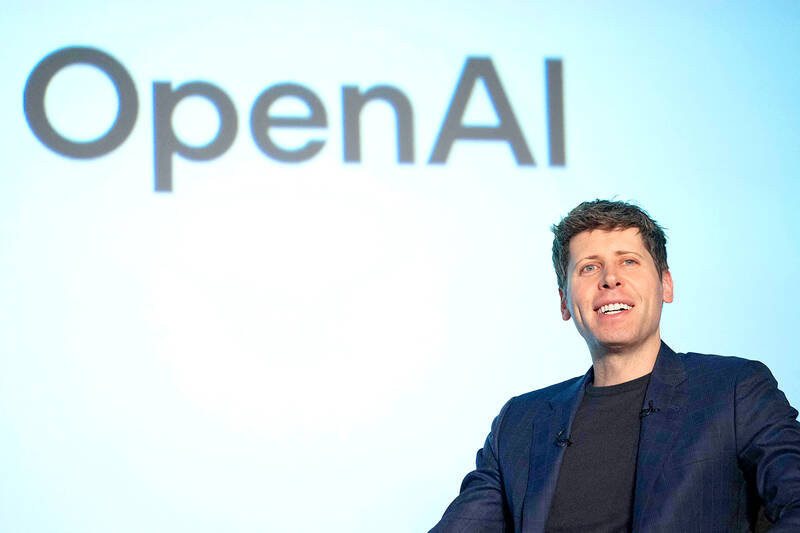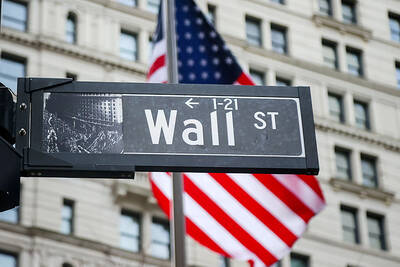OpenAI on Monday said it raised US$40 billion in a new funding round that valued the ChatGPT maker at US$300 billion, the biggest capital-raising session ever for a start-up.
ChatGPT is an artificial intelligence (AI) chatbot launched in November 2022.
The infusion of cash comes in a partnership with Japanese investment giant Softbank Group Corp and “enables us to push the frontiers of AI research even further,” the San Francisco-based company said in a post on its Web site.

Photo: AFP
“Their support will help us continue building AI systems that drive scientific discovery, enable personalized education, enhance human creativity and pave the way toward AGI [artificial general intelligence] that benefits all of humanity,” the company said.
AGI refers to a computing platform with human-level intelligence.
Softbank said in a news release that it is on a mission to realize artificial super intelligence (ASI) that surpasses human intelligence, and that OpenAI is the partner closest to achieving that goal.
“The advancement of OpenAI’s AI models is key to achieving AGI and ASI, and massive computing power is essential,” Softbank said in its rationale for the latest investment in the company.
Softbank is to pump US$10 billion into OpenAI to start, and US$30 billion more by the end of this year pending certain conditions.
OpenAI plans to scale its infrastructure and “deliver increasingly powerful tools for the 500 million people who use ChatGPT every week.”
The funding news came the same day OpenAI announced it was building a more open generative AI model as it faces growing competition in the open-source space from Chinese rival DeepSeek (深度求索) and Facebook parent Meta Platforms Inc.
The move would mark a strategic shift by OpenAI, which until now has been a fierce defender of closed, proprietary models that do not allow developers to modify the basic technology to make AI more adapted to their goals.
OpenAI and defenders of closed models — which include Alphabet Inc’s Google — have often decried open models as riskier and more vulnerable to nefarious uses by malicious actors or non-US governments.
OpenAI’s embrace of closed models has also been a bone of contention in its battles with former investor Elon Musk, who has called on OpenAI to honor the spirit of the company’s name and “return to the open-source, safety-focused force for good it once was.”
Putting pressure on OpenAI, many large companies and governments have proved reluctant to build their AI products or services on models they have no control over, especially when data security is a concern.
The core selling point of Meta’s family of Llama models or DeepSeek’s models is addressing such worries by letting companies download their models, and have far greater control to modify the technology for their own purposes and keep control of their data.
“We’ve been thinking about this for a long time, but other priorities took precedence. Now it feels important to do,” OpenAI chief executive Sam Altman wrote on X of the decision to build a more open model.
Meanwhile, the frenzy to create Ghibli-style AI art using ChatGPT's image-generation tool led to a record surge in users for the chatbot last week, straining its servers and temporarily limiting the feature's usage.
The viral trend saw users from across the globe flood social media with images based on the hand-drawn style of the famed Japanese animation outfit, Studio Ghibli, founded by renowned director Hayao Miyazaki and known for movies such as "Spirited Away" and "My Neighbor Totoro."
Average weekly active users breached the 150 million mark for the first time this year, according to data from market research firm Similarweb.
"We added one million users in the last hour," Altman said in an X post on Monday, comparing it with the addition of one million users in five days following ChatGPT's red-hot launch more than two years ago.
That claim came days after Altman said the new image features were so popular that they were melting the OpenAI graphics processing units that power the AI due to heavy use.
Additional reporting by Reuters

GROWING OWINGS: While Luxembourg and China swapped the top three spots, the US continued to be the largest exposure for Taiwan for the 41st consecutive quarter The US remained the largest debtor nation to Taiwan’s banking sector for the 41st consecutive quarter at the end of September, after local banks’ exposure to the US market rose more than 2 percent from three months earlier, the central bank said. Exposure to the US increased to US$198.896 billion, up US$4.026 billion, or 2.07 percent, from US$194.87 billion in the previous quarter, data released by the central bank showed on Friday. Of the increase, about US$1.4 billion came from banks’ investments in securitized products and interbank loans in the US, while another US$2.6 billion stemmed from trust assets, including mutual funds,

Micron Memory Taiwan Co (台灣美光), a subsidiary of US memorychip maker Micron Technology Inc, has been granted a NT$4.7 billion (US$149.5 million) subsidy under the Ministry of Economic Affairs A+ Corporate Innovation and R&D Enhancement program, the ministry said yesterday. The US memorychip maker’s program aims to back the development of high-performance and high-bandwidth memory chips with a total budget of NT$11.75 billion, the ministry said. Aside from the government funding, Micron is to inject the remaining investment of NT$7.06 billion as the company applied to participate the government’s Global Innovation Partnership Program to deepen technology cooperation, a ministry official told the

Taiwan Semiconductor Manufacturing Co (TSMC, 台積電), the world’s leading advanced chipmaker, officially began volume production of its 2-nanometer chips in the fourth quarter of this year, according to a recent update on the company’s Web site. The low-key announcement confirms that TSMC, the go-to chipmaker for artificial intelligence (AI) hardware providers Nvidia Corp and iPhone maker Apple Inc, met its original roadmap for the next-generation technology. Production is currently centered at Fab 22 in Kaohsiung, utilizing the company’s first-generation nanosheet transistor technology. The new architecture achieves “full-node strides in performance and power consumption,” TSMC said. The company described the 2nm process as

Even as the US is embarked on a bitter rivalry with China over the deployment of artificial intelligence (AI), Chinese technology is quietly making inroads into the US market. Despite considerable geopolitical tensions, Chinese open-source AI models are winning over a growing number of programmers and companies in the US. These are different from the closed generative AI models that have become household names — ChatGPT-maker OpenAI or Google’s Gemini — whose inner workings are fiercely protected. In contrast, “open” models offered by many Chinese rivals, from Alibaba (阿里巴巴) to DeepSeek (深度求索), allow programmers to customize parts of the software to suit their